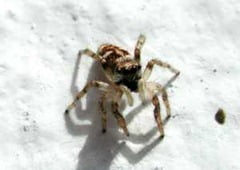 Although often overlooked because of its small size the zebra spider’s attractive black and white livery and its lively antics mean that it’s quite easy to spot if you look for it. The species is common throughout Ireland and can be found patrolling the walls of houses and gardens on sunny days throughout the summer months and well into the autumn.
Although often overlooked because of its small size the zebra spider’s attractive black and white livery and its lively antics mean that it’s quite easy to spot if you look for it. The species is common throughout Ireland and can be found patrolling the walls of houses and gardens on sunny days throughout the summer months and well into the autumn.
This diminutive hunter belongs to a large family of spiders known as jumping spiders. Instead of trapping its prey in a web like many of its relatives the zebra spider relies on its exceptional eyesight and agility to stalk and catch its prey. A relatively small spider, the zebra spider grows to no more than 7mm (c. ¼ inch) long and females tend to be slightly larger than males.
Apart from its distinctive black and white colouration the most noticeable feature of this spider are its large eyes. Eyesight plays a vital part in the life of a zebra spider, and the species is thought to have among the best eyesight of any arthropod… a group that encompasses insects, arachnids, crustaceans, and other small animals like centipedes and millipedes. The spider has eight eyes in all, but the middle two forward facing eyes are enlarged, and it is these that provide the binocular vision that allows this tiny arachnid to judge distances so effectively. A consummate hunter the zebra spider uses its acute vision to judge exactly when its prey is within striking range before pouncing with pinpoint accuracy. The remaining eyes provide superb peripheral vision, and the spider is able to detect movement from anywhere in its immediate vicinity.
Zebra spiders are curious and unafraid: if you look closely at one it will often turn its head towards you, swivel around and look straight back at you. They tend to hunt creatures their own size or smaller, but have been observed feeding on animals up to twice their own size. When a zebra spider’s detects movement in its peripheral vision it turns towards the source and locks onto it with its large front eyes. If it detects a potential meal the spider will creep slowly towards it, gradually closing the distance until it gets within pouncing range. Just before it pounces the spider will attach an anchor thread to the surface it is jumping from, so that should it miss the mark it can simply climb back up the thread and try again.
Sexes are almost identical in appearance apart from the slight size difference and the fact that males have enlarged, forward-facing black “chelicerae” or fangs. When male and female zebra spiders meet the male initiates a courtship dance that involves a lot of waving of the forelimbs and oscillating of the abdomen. The more impressive this display, the more receptive the female will be to mating with the performer, although experts have yet to establish exactly what it is that the female spider looks for in the dance of her prospective mate.
Despite having some of the best eyes in the business male zebra spiders occasionally make mistakes, and have been known to launch into their courtship dance in front of other males – an error which usually results in a fight. Male spiders can also be duped into performing their dance in a futile attempt to impress their own reflection in a mirror.
Once mating has taken place the female zebra spider lays her eggs and guards them diligently. She continues to protect her offspring once they have hatched, and the tiny spiderlings stay with their mother until their second moult, after which they disperse to fend for themselves.








1 comment
Jamie Durrant
I love these spiders! i had one that used to live on and around my desk in my hall of residence. i can’t get my head around how they jump up a vertical surface.